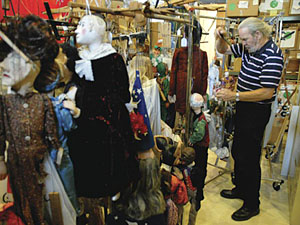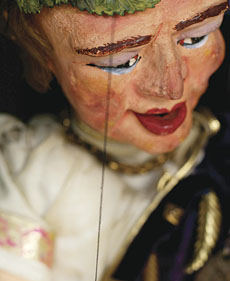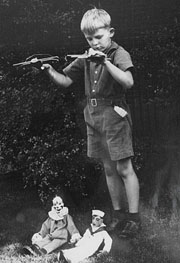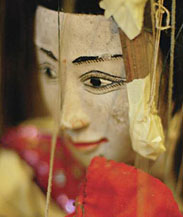|
INTERNATIONAL PUPPETRY MUSEUM
formerly The Conservatory of Puppetry Arts (COPA)
1062 N. Fair Oaks Avenue - Pasadena, CA 91103
phone - fax: 626-296-1536
Note this Website is Under Development
and is a revision of www.COPA-Puppets.org
|
|
|
Public Relations - Articles
|
Pomona College Magazine - 2006
|
With Strings
For Alan Cook '53, the finest things in the world come with strings attached.
By Hugo Martin '87
Ask Alan Cook ’53 to name his favorite puppet and he hesitates. It’s like asking a father which of his children he loves the most.
|
|
|
 |
How can he choose? He loves the Phyllis Diller puppet that is in the glass case by the front door of this church recreation hall in Pasadena. But then again, he also likes the Bob Hope puppet that is stashed away somewhere in this crowded building. Oh, and he can’t forget Eleanor Roosevelt. She is in the case next to Diller. Cook’s collection surpasses the 800 puppets at the Detroit Institute for the Arts, the 1,300 puppets at the Atlanta Center for Puppetry Arts and the 3,000 puppets at the Ballard Institute and Museum of Puppetry at the University of Connecticut.
Perhaps more amazing than the sheer size of the collection is the fact that Cook built it on donations and the meager earnings of a traveling puppet master.
|
Puppets have been a part of human history for centuries, although the exact origin of the art is the subject of dispute. What is clear is that nearly every major culture has a puppetry tradition. In Japan, the sophisticated Bunraku puppets overshadowed even the Kabuki as the most popular form of entertainment in the middle of the 18th century.One of Great Britain’s most popular and longest running acts has been “The Punch and Judy Show,” starring Mr. Punch, the rascal puppet known to flaunt conventions and defy laws. In America, the first puppet superstar was that top hat-wearing Charlie McCarthy, who ruled vaudeville, movie reels and radio with his handler, Edgar Bergen, during the 1930s, ’40s and ’50s.
The history and tradition of puppetry is not lost on Cook. In his own lifetime, he has known and worked closely with some of the most renowned puppeteers of the modern era, including Frank Paris, creator of the Howdy Doody puppet; Jim Henson, creator of the Muppets; and Sid and Marty Krofft, whose life-size puppets dominated children’s television in the 1970s and ’80s.
Cook’s collection is a tangible record of modern puppetry history. “Puppets change like everything else, and it’s valuable to show that change,” says Diane Houk, director of the Puppetry Arts Institute in Independence, Missouri, who met Cook at a puppetry festival in Seattle six years ago and believes he has one of the biggest and most well-rounded collections in the country.
|
 |
|
 |
During the Great Depression, Cook was a shy kid with bright, blue eyes who loved to ride the red car trolleys with his parents from his home in South Pasadena to downtown Los Angeles.
In historic Pershing Square they listened to sidewalk preachers, communists and socialists sermonize to the crowds. It was an exciting time, a time of social uncertainty and revolutionary fervor.
But what Cook loved most about those trips were the puppet shows put on by downtown department stores like Bullocks, Robinsons and May Co. to attract customers.
|
 |
The puppets were made of cloth, wood and string but Cook was thrilled at how they told fantastic stories of princesses, witches, dwarfs and kings. “It was the illusion of life and as a result a sense of magic that fascinated me,” he says.
Cook’s mother indulged his interest by giving him a Dutch boy marionette when he was four years old. When he was older, he rode his bicycle to nearby Alhambra to buy the latest cutout paper puppets.
|
|
Puppets appealed to Cook on a personal level. He was an introverted child, who struggled to live up to his mother’s high standards. She was a music teacher, and his father was a court reporter who later worked in the frozen food business.
Cook found that despite his shyness, through puppets he could tell stories, entertain crowds and take on a comic persona. As a teenager, he put on puppet shows for the neighborhood kids, sending out fliers and charging 50 cents a ticket.
Although both of Cook’s parents graduated from USC, it was Pomona College that played a recurring role in his life. In high school, his 10th-grade English teacher, a Pomona College alumna named Minnie Ruth Dexter ’46, assigned Cook to write about his goals and ambitions. He wrote for the first time about his dream of becoming a puppeteer.
“It was in her class that that momentous shift occurred,” he says.
Later, Dexter convinced Cook to apply to Pomona College, where he studied art history. During his college years, he continued to pursue puppetry, putting on shows for nearby children stricken with cerebral palsy.
|
 |
|
After graduation, he was drafted into the Army during the Korean War. He never left the country, however. The Army put him to work in the medical corps, handing out supplies.
After the war, Cook lived the life of a struggling artist, working at puppetry festivals, on television shows and on Las Vegas novelty acts. Still, he was happy just being around puppets and puppeteers.
His resume includes working during the 1970s on a Las Vegas act involving a chorus line of dancing puppets that opened up for actress Raquel Welch. He helped make hamburger puppets sing for a television commercial for McDonald’s restaurants. He worked with stop-action animation in the 1960s to help bring the Pillsbury Doughboy to life. And he put on puppet shows at amusement parks like Magic Mountain and Knott’s Berry Farm.
Along the way, he became a member of America’s tight-knit league of puppeteers. Puppeteers share a bond, partly from being part of what Cook describes as the orphan child of the performing arts. They look after each other, knowing few outside of puppetry understand their passion.
When Howdy Doody creator Paris was dying, Cook cared for him for three months until Paris succumbed to lung cancer in 1984.
Cook has never been married and when asked if he has any children he replies “only my puppets,” many of them orphans.
He has amassed his family mostly by scrounging puppets that others were ready to discard.
Once, while in New York, a puppeteer who was working on the Howdy Doody show mentioned that the show had just thrown away a gold-painted puppet, made to look like a rich aristocrat. Cook dove into the dumpster and saved the puppet.
Other puppets came into Cook’s collection thanks to the donations of fellow puppeteers.
It’s in the cluttered Pasadena church building across from a noisy public park that the hand-carved faces of dolls from Mali, delicate porcelain marionettes from China and intricate shadow puppets from Malaysia keep him company as he tries to put order to his collection.
He still has his first homemade puppet—a clown he constructed from papier mache and the wood of an orange crate. He hopes this puppet will be a part of the collection long after he is gone. Cook plans to make the Conservatory of Puppetry Arts the beneficiary of his collection. He looks forward to the day that puppets get the same respect as paintings and sculptures in the world of art. When that day comes, he says, maybe his collection will find a home in a spacious museum with lots of public access.
For now, Cook is content to box up the best of his puppets and haul them around the country for viewing at puppetry festivals and exhibitions.
“When I look back,” says Cook, sitting among his children in the church building, “I don’t know how I did it. But you learn to be frugal and not to throw anything away.”
To see Cook’s puppets or support the conservatory, visit www.copa-puppets.org.edu/Magazine
www.pomonacollege
©Copyright 2006
by Pomona College
Pomona College Magazine • 550 N. College Ave, Claremont, CA 91711 • Contact us for editorial matters
|
|
CONTRIBUTIONS NEEDED:
To continue the important job of conserving this world class puppet collection, IPM needs more storage space! We are looking for a unit or units to install on Alan Cook’s back lot. If you have or know of a source for clean and secure units that are free or reasonable, please contact : IPM (626) 296-1535 mail@PuppetryMuseum.org.
.................................................................
|
Back to the top
|
|
Copyright © 2008 IPM, All Rights Reserved.
Web design
by CreatingMarks.com -
phone: 818-759-0402 |e-mail: Lisa@creatingmarks.com |
|
|